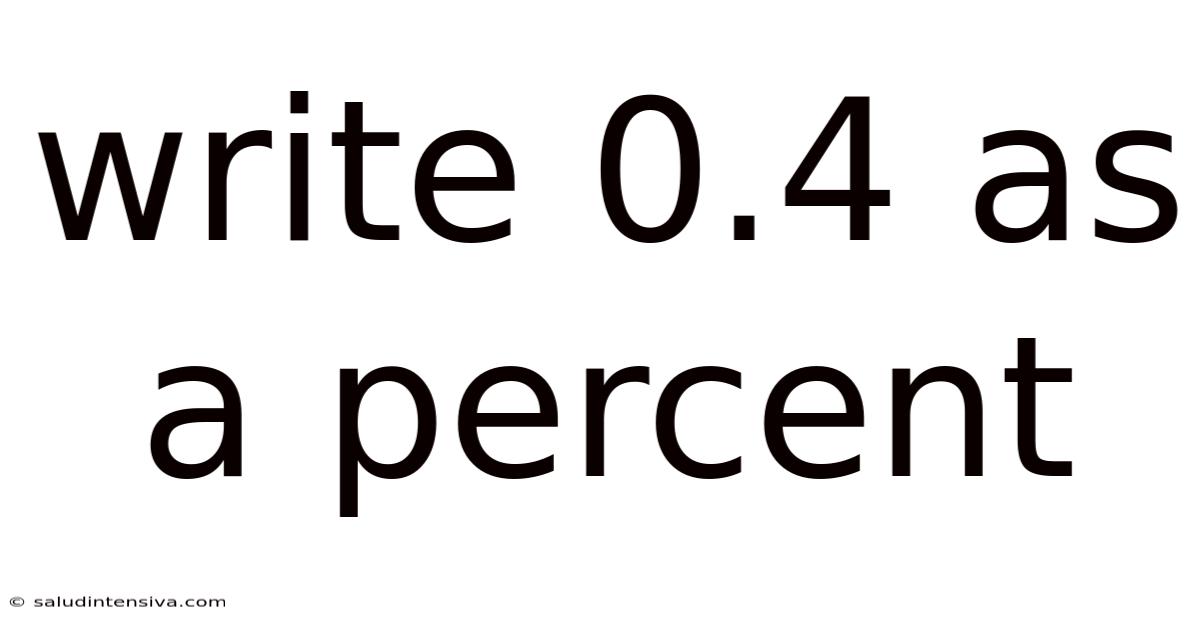Write 0.4 As A Percent
saludintensiva
Sep 14, 2025 · 4 min read

Table of Contents
Writing 0.4 as a Percent: A Comprehensive Guide
Converting decimals to percentages is a fundamental skill in mathematics with applications across numerous fields, from finance and statistics to everyday budgeting and shopping. This comprehensive guide will explore the process of converting the decimal 0.4 into a percentage, explaining the underlying principles and providing a deeper understanding of the relationship between decimals and percentages. We'll cover various methods, address common misconceptions, and delve into the practical implications of this conversion. By the end, you'll not only know that 0.4 is equal to 40%, but you'll also have a solid grasp of the concepts involved.
Understanding Decimals and Percentages
Before diving into the conversion, let's establish a clear understanding of decimals and percentages. A decimal is a way of writing a number that is not a whole number. It uses a decimal point to separate the whole number part from the fractional part. For example, 0.4 represents four-tenths (4/10).
A percentage, denoted by the symbol %, represents a fraction of 100. It expresses a proportion or rate out of 100. For instance, 40% means 40 out of 100, or 40/100. The key to understanding the conversion lies in recognizing that percentages are essentially fractions with a denominator of 100.
Method 1: The Multiplication Method
The most straightforward method to convert a decimal to a percentage is to multiply the decimal by 100%. This method leverages the fundamental relationship between decimals and percentages: multiplying by 100% is equivalent to multiplying by 1, which doesn't change the value, only the representation.
Steps:
- Write down the decimal: 0.4
- Multiply by 100%: 0.4 × 100%
- Perform the multiplication: 40%
Therefore, 0.4 as a percent is 40%.
Method 2: The Fraction Method
This method involves converting the decimal into a fraction and then converting that fraction to a percentage. This approach offers a deeper understanding of the underlying mathematical principles.
Steps:
- Convert the decimal to a fraction: The decimal 0.4 can be written as 4/10.
- Simplify the fraction (if possible): 4/10 simplifies to 2/5.
- Convert the fraction to a percentage: To convert a fraction to a percentage, multiply the fraction by 100%. (2/5) × 100% = (2 × 100%) / 5 = 200%/5 = 40%
Again, we arrive at the answer: 0.4 is equal to 40%.
Method 3: Understanding Place Value
This method relies on understanding the place value system within decimals. Each position to the right of the decimal point represents a decreasing power of 10. The first position after the decimal is tenths (1/10), the second is hundredths (1/100), and so on.
Since a percentage is a fraction out of 100, we need to express the decimal in terms of hundredths. 0.4 is four-tenths, which is equivalent to 40 hundredths (40/100). Therefore, 0.4 is 40%. This method visually reinforces the relationship between the decimal and its percentage equivalent.
Practical Applications and Examples
The conversion of decimals to percentages finds widespread use in various contexts:
- Finance: Calculating interest rates, discounts, and profit margins often involves converting decimals to percentages. For example, an interest rate of 0.05 is equivalent to 5%.
- Statistics: Representing data proportions and probabilities uses percentages extensively. If 0.4 of a sample population prefers a particular product, it means 40% prefer it.
- Everyday life: Sales discounts (e.g., 40% off), tax rates, and survey results are commonly expressed as percentages.
Example 1: Sales Discount
A store offers a discount of 0.4 on the original price. This means the discount is 40%. If an item costs $100, the discount would be $40 (0.4 × $100 = $40).
Example 2: Test Scores
A student scores 0.75 on a test. This translates to 75%.
Common Misconceptions and Troubleshooting
A common misconception is to simply move the decimal point two places to the right. While this works as a shortcut, it's crucial to understand why it works. It's essentially a quick way to multiply by 100. Without understanding the underlying concept, this shortcut can be easily misused.
Frequently Asked Questions (FAQ)
Q: Can all decimals be easily converted to percentages?
A: Yes, all decimals can be converted to percentages using the methods described above. Even decimals with more than one digit after the decimal point can be converted using the same principles.
Q: What if I have a decimal greater than 1?
A: The same principles apply. For instance, 1.25 is equal to 125%. Multiply by 100% to obtain the percentage.
Q: How do I convert a percentage back to a decimal?
A: Divide the percentage by 100. For example, 40% / 100 = 0.4.
Conclusion
Converting 0.4 to a percentage is a simple yet fundamental mathematical operation with wide-ranging applications. Whether you utilize the multiplication method, the fraction method, or the place value approach, understanding the underlying principles of decimals and percentages is essential. This guide has provided a detailed explanation of the conversion process, explored various methods, highlighted practical applications, and addressed common misconceptions, equipping you with a comprehensive understanding of this critical mathematical concept. Remember, mastering this skill strengthens your foundation in mathematics and enhances your ability to interpret and utilize numerical data effectively in diverse real-world scenarios.
Latest Posts
Latest Posts
-
5 9 As A Decimal
Sep 14, 2025
-
Lcm Of 3 And 14
Sep 14, 2025
-
Cubic Feet To Yards Soil
Sep 14, 2025
-
29 Acres To Sq Ft
Sep 14, 2025
-
1 Yard To Square Foot
Sep 14, 2025
Related Post
Thank you for visiting our website which covers about Write 0.4 As A Percent . We hope the information provided has been useful to you. Feel free to contact us if you have any questions or need further assistance. See you next time and don't miss to bookmark.